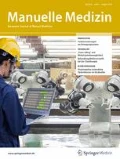Zusammenfassung
Hintergrund
Manualmedizinische Verfahren werden in der Sportbetreuung von den Anwendern mehrheitlich als positiv angesehen. Die Einschätzung reicht vom positiven Einfluss bei der Rehabilitation von Sportverletzungen über die Prophylaxe von Sportverletzungen bis hin zur Möglichkeit der Leistungssteigerung. Grundlage sind neurophysiologische Erklärungsmodelle, die nahelegen, dass funktionelle Störungen zu einer veränderten Gelenkbeweglichkeit und muskulären Koordination führen, die durch geänderte Bewegungsabläufe ein höheres Verletzungsrisiko und eine verminderte Leistungsfähigkeit zu Folge haben.
Ergebnisse
Als definitiv nachgewiesen kann der positive Einfluss in der Behandlung von Sportverletzungen angesehen werden. Bezüglich der Verletzungsprophylaxe und der Leistungssteigerung liegen bisher nur wenige, häufig gegensätzliche Daten vor. Insofern ist eine sichere Aussage zum Effekt der manuellen Medizin in diesem Zusammenhang bisher nicht möglich. Um das tatsächliche Potenzial manualmedizinischer Verfahren zu verifizieren, sind zukünftig weitere Studien zu diesen Fragestellungen notwendig.
Abstract
Manual medicine techniques are thought to have positive effects in treating athletes. Most of the users believe that they can reduce rehabilitation time after sports injuries, can reduce sports related injuries, and can cause improvements in athlete’s sports performance. This mention is based on neurophysiologic models, suggesting that restricted joint motion can cause abnormal mechanics and reflex muscular incoordination which in turn could result in a higher risk of injuries and reduced performance. Positive effects of manual medicine are evident in the rehabilitation of sports injuries. Referring to the prophylaxis of sports injuries and sport performance enhancement, there are only a small number of studies with inconsistent results. Therefore, no definitive answer can yet be postulated as to whether manual medicine techniques have an appreciable effect in this area and additional research is clearly warranted.
Literatur
Adams E, Madden C (2009) Cuboid subluxation: a case study and review of the literature. Curr Sports Med Rep 8:300–307
Botelho MB, Andrade BB (2012) Effect of cervical spine manipulative therapy on judo athletes‘ grip strength. J Manipulative Physiol Ther 35:38–44
Costa SMV, Chibana YET, Giavarotti L et al (2009) Effect of spinal manipulative therapy with stretching compared with stretching alone on full-swing performance of golf players: a randomized pilot trial. J Chiropr Med 8:165–170
DeVocht JW, Pickar JG, Wilder DG (2005) Spinal manipulation alters electromyographic activity of paraspinal muscles: a descriptive study. J Manipulative Physiol Ther 28:465–471
Grimston SK, Engsberg JR, Shaw L, Vetanze NW (1990) Muscular rehabilitation prescrubed in coordination with prior chiropractic therapy as a treatment for sacroiliac subluxation in female distance runners. Chiropr Sports Med 4:2–8
Haldemann S (1986) Spinal manipulative therapy in sports medicine. Clin Sports Med 5:277–291
Hoskins W, Pollard H (2010) The effect of a sports chiropractic manual therapy intervention on the prevention of back pain, hamstring and lower limb injuries in semi-elite Australian rules footballers: a randomized controlled trial. BMC Musculoskelet Disord 11:64–74
Hoskins W, Pollard H, Daff C et al (2009) Low back pain status in elite and semi-elite Australian football codes: a cross-sectional survey of football (soccer), Australian rules, rugby league, rugby union and non-athletic controls. BMC Musculoskelet Disord 10:38–46
Hoskins WT, Pollard HP (2005) Successful management of harmstring injuries in Australian rules footballers: two case reports. Chiropr Osteopat 13:4–8
Hungerford B, Gilleard W, Hodges P (2003) Evidence of altered lumbopelvic muscle recruitment in the presence of sacroiliac joint pain. Spine 28:1593–1600
Jennings J, Davies GJ (2005) Treatment of cuboid syndrome secondary to lateral ankle spraints. A case series. J Orthop Sports Phys Ther 35:409–415
Konczak CR (2010) Chiropractic utilization in BMX athletes at the UCI World Championships: a retrospective study. J Can Chiropr Assoc 54:250–256
Marshall P, Hamilton WG (1992) Cuboid subluxation in ballet dancers. Am J Sports Med 20:169–175
Marshall P, Murphy B (2006) The effect of sacroiliac joint manipulation on feed-forward activation times of the deep abdominal musculature. J Manipulative Physiol Ther 29:196–202
Ménétrey J, Fritschy D (1999) Subtalar subluxation in ballet dancers. Am J Sports Med 27:143–149
Miners AL (2010) Chiropractic treatment and the enhancement of sports performance: a narrative literature review. J Can Chiropr Assoc 54:210–221
Miners AL, Graauw C de (2010) A survey of fellows in the College of Chiropractic Sports Science (Canada): their intervention practices and intended therapeutic outcomes when treating athletes. J Can Chiropr Assoc 54:282–292
Newell SG, Woodle A (1981) Cuboid syndrome. Phys Sports Med 9:71–76
Petering RC, Webb C (2011) Treatment options for low back pain in athletes. Sports Health 3:550–555
Prokop LL, Wieting JM (1996) The use of manipulation in sports medicine practice. Phys Med Rehabil Clin North Am 7:915–933
Sandell J, Palmgren PJ, Björndahl L (2008) Effect of chiropractic treatment on hip extension ability and running velocity among young male running athletes. J Chiropr Med 7:39–47
Shrier I, MacDonald D, Uchacz G (2006) A pilot study on the effects of pre-event manipulation on jump height and running velocity. Br J Sports Med 40:947–949
Suter E, McMorland G, Herzog W, Bray R (2000) Conservative lower back treatment reduces inhibition in knee-extensor muscles: a randomized controlled trail. J Manipulative Physiol Ther 23:76–80
Suter E, McMorland G, Herzog W, Bray R (2002) Decrease in elbow flexor inhibition after cervical spine manipulation in patients with chronic neck pain. Clin Biomech 17:541–544
Wang SS, Meadows J (2010) Immediate and carryover changes of C5–6 joint mobilization on shoulder external rotator muscle strength. J Manipulative Physiol Ther 33:102–108
Zak K (1997) Besteht ein Zusammenhang zwischen Sportverletzungen an der Schulter und funktionellen Störungen der Wirbelsäule? Manuelle Med 35:149–151
Einhaltung ethischer Richtlinien
Interessenkonflikt. R. Klett gibt an, dass kein Interessenkonflikt besteht. Dieser Beitrag beinhaltet keine Studien an Menschen oder Tieren.
Author information
Authors and Affiliations
Corresponding author
Rights and permissions
About this article
Cite this article
Klett, R. Möglichkeiten und Grenzen der Manualmedizin im Sport. Manuelle Medizin 52, 97–100 (2014). https://doi.org/10.1007/s00337-014-1101-9
Published:
Issue Date:
DOI: https://doi.org/10.1007/s00337-014-1101-9

